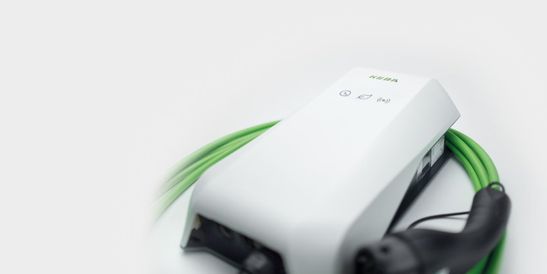Step by step to your own wallbox
- Knowledge
- Charging
- Private
- 17.1.2023
- Reading Time: {{readingTime}} min
- Share Article

Contents
You’ve ordered your electric car but don’t have your own charging station yet? Follow these four points if you wish to install a wallbox at home.
1. Checking existing electrical wiring
A charging station requires a sufficiently powerful supply line with suitable circuit protection. Moreover, charging rates of more than 7.4 kW require a three-phase connection. Such rates are often called high voltage. If you already have a high-voltage connection – generally identified with a red socket – in your garage or parking space, there’s little that stands in the way of a proper wallbox installation. There are special companies that offer evaluations of your wires, cables, and protection – and give you additional reassurance.
If you’re building your house from scratch, you will want to plan for adequate cabling.
2. Assessing the environment
If the charging station is to be installed in or near your own home, you won’t need a license to do so. In many areas, the only mandatory thing to do is to notify the power provider, as each new charging station tends to require a higher power output. In rare cases, you may be required to install an electricity meter.
Rental accommodations are a different story. You will need to obtain the landlord’s or landlady’s permission. Installing a wallbox in multi-party accommodations – even if you own the apartment – also requires the prior consent of the other apartment owners. However, the respective laws are being adapted. A “right to plug” is underway. In Austria, for instance, the approval limit was raised to 3.7 kW in 2022. Only more powerful charging stations now require the permission of the other owners. Hybrid vehicles with smaller batteries reach that limit.
3. Choosing the right wallbox
The use requirements – which charging rate do I need; do I want to charge with my own PV power; do I pass on charging costs; do I want access restrictions; do I want a wallbox with cable or socket? – automatically lead to a personalized wallbox shortlist. For a quick and easy evaluation of the requirements without expert knowledge, we at KEBA have developed the Wallbox Finder. Simply answer a few questions about your charging situation, and you will get the right product tailored to your needs.
Since a charging station is often used for many years, the price should not be the most important criterium. Safety, reliability, and guaranteed updateability might cost a bit more initially but will save you time and effort in the long run. You may want to check whether the wallbox you want is eligible for financial aid programmes available in your region. This might cut overall costs considerably.
4. Installation by a specialist
If all the technical, legal, and needs-related questions are answered, the actual installation swings into focus. And there’s no way around a certified specialist. After all, there are voltages in play that are potentially dangerous for people, vehicles, and the entire building’s wiring. Additionally, the likelihood of financial aid is highly dependent on a proper installation. By having a specialist inspect your building’s wiring prior to the installation, you can discuss special requests like connecting the wallbox to a PV system or integrating it into your Smart Home as well as the necessary structural measures. You decide how much time and material should be invested, which then determines the installation costs. You could decide to do any necessary preliminary work such as excavation – e.g. to lay cables in the yard – by yourself, in order to cut expenses.


























